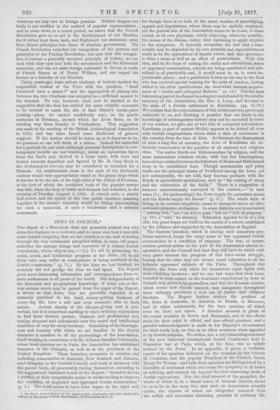BOOKS.
THE LIFE OF SIMON DE MONTFORT.*
Mn. G. W. PROTHERO'S book is the third life of the great Earl which has been published within the last twelve months. It is a careful and valuable work, and being written with special re- ference to the Parliamentary history of the time, and discussing as it does with great ability the views of Pauli and Stubbs on that topic, it may be confidently recommended as, on the whole, the best we now have on the subject. The scientific study of history, based on the careful examination and comparison of con- temporary records, has produced what is perhaps the most en- during literature of our age, and Mr. Prothero will doubtless take his place therein, if we may regard the present work as an earnest
*
an ras We of simon (le Montfort, ite By d 00. 1877. • G. W. Prothero. London: Longinans
of the ability of a new student in the field of historical research and elucidation.
But the attempt to combine an historical narrative with the details of political disquisition is a difficult one, and in the present ease not altogether successful. We do not feel that we have yet got a living picture of the person and character of de Montfort. The materials are accumulating, but they still wait for some writer who has sufficient insight and imagination to select the essential features and combine them. When this shall be done, the Earl's foreign birth and parentage, and even his association with the Albigensian persecutor, will be forgotten. Already it is clearly recognised that he was, during the last twenty years of his life, the leader of a popular party in the State (or at least of
a party representing popular interests), made up of a few of the greater and many of the lesser Barons, learned and liberal Church-
men and scholars, and the burgesses of the rising municipalities. Although he gained the confidence of his party but slowly, and not unfrequently hasazded and even forfeited their support by an im- perious and impatient temper, he yet became the actual leader of the first great attempt to establish national rights and interests against Royal absolutism and Papal authority. His familiar in- tercourse with such men as Grosteste and Marisa°, the sacredness of his domestic life, his magnanimity, whether as a servant of the King in the affairs of Gascony, or as adviser and head of the Baronial party, his popular sympathies, his singular union of the characters of saint and warrior, combine to form a person of heroic mien, requiring for its complete delineation no less a poetical than an historical imagination. Mr. Prothero shows a high appreciation of all the elements of de Montfort's excellence,
and has written generally with force and distinctness ; and that his views are moderate and carefully formed, while fully up to the advance of his knowledge of his subject, is apparent in the follow- ing passage, which is a summing-up of his tenth chapter, "On the Government of Simon de Montfort: "— "Thus, then, there appears in the work of Simon de Montfort, apart from the two most important points explained above, hardly so much novelty as he usually receives credit for. He can hardly be called without reserve the 'creator of the House of Commons,' though to him, doubtless, is owing far more than to any other individual. Still lose can the famous Parliament of 1265 be said to consist of completely new elements.' Simon would have been the first to repudiate so radical a change as those words seem to imply. His mind was as truly Con- servative as it was truly Liberal. It seems, therefore, useless to guess whether he was influenced by a possible acquaintance with the popular institutions of Aragon, or took hints from the Constitution which Frederick the Great set up in his kingdom of Sicily. With a far wiser spirit of reform, be worked upon existing materials, and with his adopted country he made her principles his own. His claim to our gratitude is a claim which has hitherto seemed to belong specially to English re- formers,—a claim which rests on the development and adaptation of popular institutions, on a constant and disinterested pursuit of the truest political education of the people. The Constitution of 1264 shows Earl Simon in the light of a far-seeing politician,—a man of groat ideas. The Parliaments of 1264 and 1265 prove him a wise statesman and a practical reformer. Ho can afford to have tho claim for novelty put in the second place, for greater praise cannot be given to a statesman than that he has clearly perceived and has fostered into a stronger life that which already exists of good."
Having recently brought this subject before our readers, we do not propose to carry our review of Mr. Prothero's book into detail, We may add that his description of the battle of Leaves is assisted by a very useful map,—a great want in M. Blaauw's first and fullest modern description of that battle, and which still remains, so far as we know, the best. For assisting the reader to a distinct notion of the battle of Evesham we cannot wholly com- mend Mr. Prothero's map, or agree with his account of that contest. More local knowledge and repeated comparison there- with of contemporary accounts (which are doubtless very conflict- ing) are still required. But these will be forthcoming when the widening interest in the subject is further extended. We may, however, safely assert the fact that after the expiration of six hundred years, Simon de Montfort takes an undisputed place among the great names in English history, and if we are asked what has mainly led to this tardy recognition, we suggest that it is due almost entirely to our having attained a knowledge of the true nature of the great national struggle of the seventh century,
—the "great rebellion," as it may still be fairly called. Historians of the seventeenth century habitually now refer back to the scarcely less great rebellion of the thirteenth century. If our Parliamentary system is based on the anti-Royalist movement of 1640-1660, no less can its real origin be traced to that of 1245 to 1265. In both periods we have a purely national contest, and not a dynastic or even partially foreign one, and in the whole line of events of which these periods are the landmarks, we perceive a purely national development. We may confidently affirm that for our political growth we owe little or nothing to foreign nationalities,
whatever we may owe to foreign persons. Neither Aragon nor Sicily is our creditor in the method of popular representation ; and to come down to a recent period, we assert that the French Revolution gave us no aid in the development of our liberties, for it rather kept them back, and frightened our statesmen away from liberal principles into those of absolute government. The French Revolution retarded our recognition of the persons and principles of the Puritan Revolution, but now that this recogni- tion is become a generally accepted principle of history, we can look with clear eyes into both the seventeenth and the thirteenth centuries, and can set aside foreign jealousies in favour as easily of French Simon as of Dutch William, and can regard the former as a founder of our liberties.
Thirty years ago, some ardent students of history startled the respectable readers of the Times with the question, "Shall Cromwell have a statue Y" and the impropriety of placing him between the two Charleses was accepted as a sufficient answer to the demand. No one, however, need now be startled at the suggestion that the time has arrived for some suitable memorial to be erected to mark the site of Earl Simonla burial-place (resting - place, we cannot confidently say), on the gentle eminence at Evesham, around which the Avon flows, on its winding way from Naseby to Tewkesbury. This suggestion was made at the meeting of the British Arehmological Association in 18M, and has since found some likelihood of general support. If the matter should be taken up as it deserves to be, we presume no one will think of a statue. Indeed the materials for a portrait do not exist (although personal descriptions in con- temporary records are not wanting), unless an equestrian figure from the Earl's seal, clothed in a loose tunic, with horn and hound, recently described and figured by Mr. de Gray Birch in the Archeological Journal, may be considered as intended for a likeness, An architectural cross in the style of the thirteenth century would very appropriately stand on the grassy slope which is known to be the site of the high-altar of the Abbey of Evesham, at the foot of which the mutilated body of the popular martyr was laid, when the fury of battle and tempest had subsided, in the evening of Tuesday, August 4, 1265. A ruined arch, a stately bell-tower, and the spires of the two parish churches standing together in the ancient cemetery would be fitting surroundings for such a memorial, at once a tombstone and a national monument.































 Previous page
Previous page